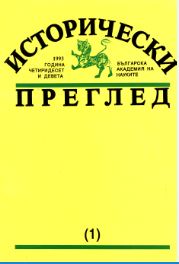За социалната структура и върховната власт в одриската и гетската политически формации
Social Structure and Supreme Power in the Political Formations of the Odrisae and Getae
Author(s): Jurij KabakchievSubject(s): History, Political history, Ancient World
Published by: Институт за исторически изследвания - Българска академия на науките
Summary/Abstract: The socio-administrative structure is a problem of particular importance for elucidating a number of phenomena in the history of the two major Thracian political formations which emerged and developed on both sides of the Haemus Mountains during the period from the 5th c. B.C. to the 2nd c. A.D. – the “kingdoms” of the Odrysae and Getae. Only the clarification of this problem would make possible our information about these "kingdoms" to be transformed from a mechanical assembly of events, cursorily indicated in the sources as details of the political life of the Northeastern Mediterranean, into a comprehensive system with its inherent mechanisms. This article deals with some of the pieces of information which are most directly connected with the question posed. Information in Thucydides, Diodorus, Strabo, Dion Cassius, Jordanes and other ancient authors make possible the formulation of more definitive views. In a social and administrative context the communities of Odrysae and Getae developed as the same type, the analogous processes proceeding with a difference in time of about five centuries. In the 5th – 1st c. B.C. in the two communities, on the basis of a two-layer social system, crystallized a triple rank administrative structure: a circle of persons particularly close to the ruler; “royal” officials and employees in the local administration, and peasants-serfs. During the same period the administrative structure was finally centralized. The dual rule of the religious leader and the military chieftain was gradually transformed into the actual personal rule of the “king” or, it seems, with the still existing, but now in a subordinate position, institution of the co-ruler. The role of the general assembly declined, which also was the result of administrative centralization and a sign of etatism.
Journal: Исторически преглед
- Issue Year: 1993
- Issue No: 3
- Page Range: 70-75
- Page Count: 6
- Language: Bulgarian
- Content File-PDF

